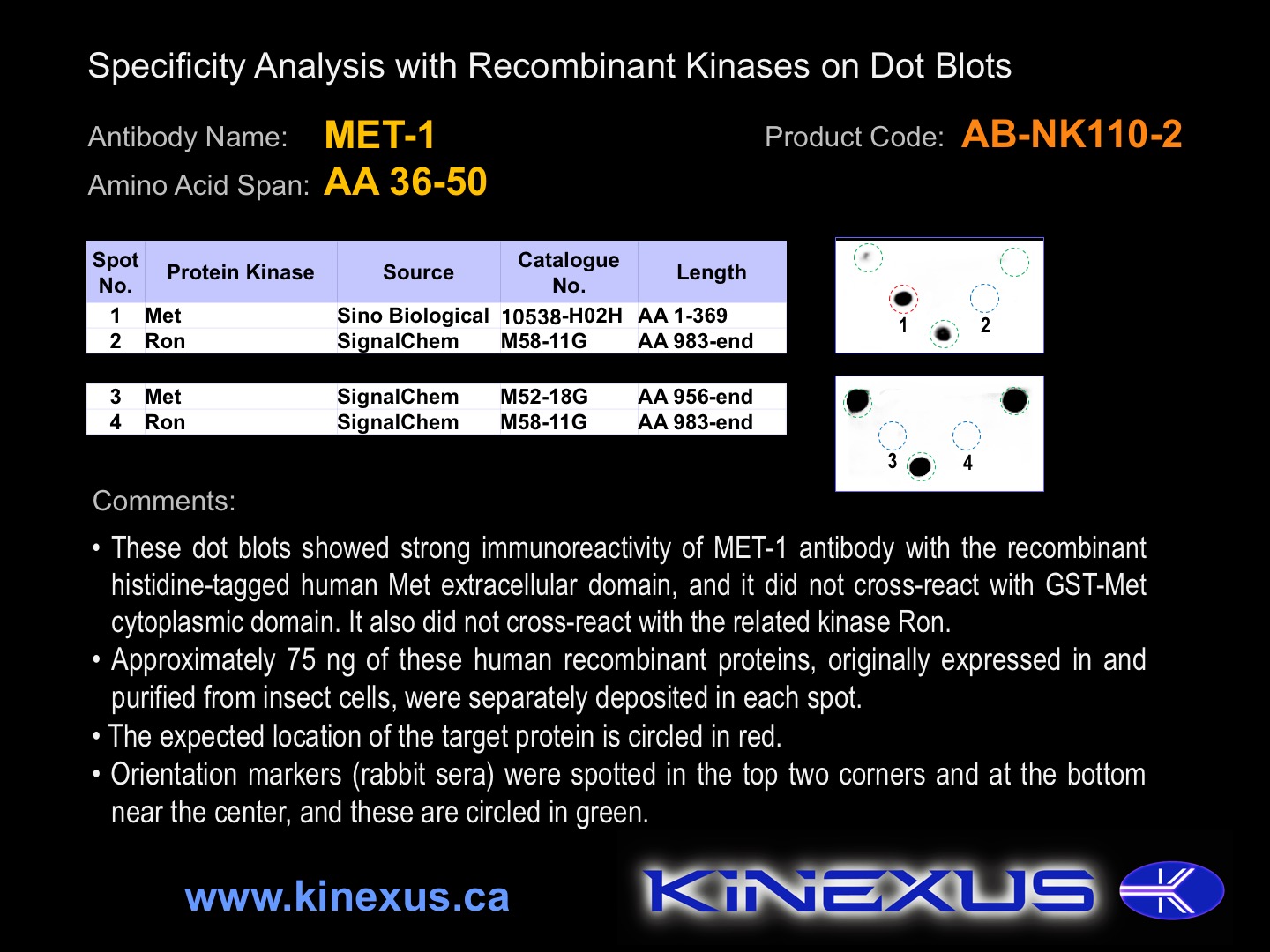Product Name: Met-1
Product Number: AB-NK110-2
| Size: | 25 µg | Price: | 89.00 | |
| $US |
Target Full Name: Hepatocyte growth factor (HGF) receptor-tyrosine kinase
Target Alias: C-met; Hepatocyte growth factor receptor; HGF receptor; HGFR; HGF-SF receptor; Kinase Met; Met proto- oncogene tyrosine kinase; Met proto-oncogene; RCCP2; ENSG00000105976
Product Type Specific: Protein kinase pan-specific antibody
Antibody Code: NK110-2
Antibody Target Type: Pan-specific
Protein UniProt: P08581
Protein SigNET: P08581
Antibody Type: Polyclonal
Antibody Host Species: Rabbit
Antibody Immunogen Source: Human Met sequence peptide Cat. No.: PE-01ASA95
Target Alias: C-met; Hepatocyte growth factor receptor; HGF receptor; HGFR; HGF-SF receptor; Kinase Met; Met proto- oncogene tyrosine kinase; Met proto-oncogene; RCCP2; ENSG00000105976
Product Type Specific: Protein kinase pan-specific antibody
Antibody Code: NK110-2
Antibody Target Type: Pan-specific
Protein UniProt: P08581
Protein SigNET: P08581
Antibody Type: Polyclonal
Antibody Host Species: Rabbit
Antibody Immunogen Source: Human Met sequence peptide Cat. No.: PE-01ASA95
Antibody Immunogen Sequence: CNVNMKYQLPNFTAET
Antibody Immunogen Description: Corresponds to amino acid residues N36 to T50; Post-N-terminus in the extracellular domain of the receptor.
Production Method: The immunizing peptide was produced by solid phase synthesis on a multipep peptide synthesizer and purified by reverse-phase hplc chromatography. Purity was assessed by analytical hplc and the amino acid sequence confirmed by mass spectrometry analysis. This peptide was coupled to KLH prior to immunization into rabbits. New Zealand White rabbits were subcutaneously injected with KLH-coupled immunizing peptide every 4 weeks for 4 months. The sera from these animals was applied onto an agarose column to which the immunogen peptide was thio-linked. Antibody was eluted from the column with 0.1 M glycine, pH 2.5. Subsequently, the antibody solution was neutralized to pH 7.0 with saturated Tris.
Antibody Immunogen Description: Corresponds to amino acid residues N36 to T50; Post-N-terminus in the extracellular domain of the receptor.
Production Method: The immunizing peptide was produced by solid phase synthesis on a multipep peptide synthesizer and purified by reverse-phase hplc chromatography. Purity was assessed by analytical hplc and the amino acid sequence confirmed by mass spectrometry analysis. This peptide was coupled to KLH prior to immunization into rabbits. New Zealand White rabbits were subcutaneously injected with KLH-coupled immunizing peptide every 4 weeks for 4 months. The sera from these animals was applied onto an agarose column to which the immunogen peptide was thio-linked. Antibody was eluted from the column with 0.1 M glycine, pH 2.5. Subsequently, the antibody solution was neutralized to pH 7.0 with saturated Tris.
Antibody Modification: Unconjugated. Contact KInexus if you are interest in having the antibody biotinylated or coupled with fluorescent dyes.
Antibody Concentration: 0.75 mg/ml
Storage Buffer: Phosphate buffered saline pH 7.4, 0.05% Thimerasol
Storage Conditions: For long term storage, keep frozen at -40°C or lower. Stock solution can be kept at +4°C for more than 3 months. Avoid repeated freeze-thaw cycles.
Product Use: Western blotting | Antibody microarray
Antibody Dilution Recommended: 2 µg/ml for immunoblotting
Antibody Potency: Medium immunoreactivity with recombinant human Met on protein dot blots.
Antibody Species Reactivity: Human
Antibody Concentration: 0.75 mg/ml
Storage Buffer: Phosphate buffered saline pH 7.4, 0.05% Thimerasol
Storage Conditions: For long term storage, keep frozen at -40°C or lower. Stock solution can be kept at +4°C for more than 3 months. Avoid repeated freeze-thaw cycles.
Product Use: Western blotting | Antibody microarray
Antibody Dilution Recommended: 2 µg/ml for immunoblotting
Antibody Potency: Medium immunoreactivity with recombinant human Met on protein dot blots.
Antibody Species Reactivity: Human
Antibody Positive Control: The observed molecular mass of the processed target protein on SDS-PAGE gels is reported to be around 140-155 kDa.
Antibody Cross Reactivity: No immunoreactivity on protein dot blots with recombinant human Ron.
Related Product 1: Met-1 blocking peptide
Related Product 2: Met-3 pan-specific antibody (Cat. No.: AB-NK110-4)
Related Product 3: Met-pS1236 phosphosite-specific antibody (Cat. No.: AB-PK705)
Related Product 4: Met-pT1241 phosphosite-specific antibody (Cat. No.: AB-PK706)
Related Product 5: Met-pT1355+pY1356 phosphosite-specific antibody (Cat. No.: AB-PK707)
Antibody Cross Reactivity: No immunoreactivity on protein dot blots with recombinant human Ron.
Related Product 1: Met-1 blocking peptide
Related Product 2: Met-3 pan-specific antibody (Cat. No.: AB-NK110-4)
Related Product 3: Met-pS1236 phosphosite-specific antibody (Cat. No.: AB-PK705)
Related Product 4: Met-pT1241 phosphosite-specific antibody (Cat. No.: AB-PK706)
Related Product 5: Met-pT1355+pY1356 phosphosite-specific antibody (Cat. No.: AB-PK707)
Related Product 6: Met-pY1003 phosphosite-specific antibody (Cat. No.: AB-PK708)
Related Product 7: Met-pY1230 phosphosite-specific antibody (Cat. No.: AB-PK709)
Related Product 8: Met-pY1234 phosphosite-specific antibody (Cat. No.: AB-PK710)
Related Product 9: Met-pY1234+pY1235 phosphosite-specific antibody (Cat. No.: AB-PK711)
Related Product 10: MetSubtide - Met protein kinase substrate peptide
Related Product 7: Met-pY1230 phosphosite-specific antibody (Cat. No.: AB-PK709)
Related Product 8: Met-pY1234 phosphosite-specific antibody (Cat. No.: AB-PK710)
Related Product 9: Met-pY1234+pY1235 phosphosite-specific antibody (Cat. No.: AB-PK711)
Related Product 10: MetSubtide - Met protein kinase substrate peptide
Scientific Background: Met (HGFR) is a protein-tyrosine kinase of the TK group and Met family. It is activated by binding hepatocyte growth factor (HGF), which induces dimerization and autophosphorylation. Phosphorylation of Y1003 increases phosphotransferase activity and induces interaction with Cbl. Phosphorylation of Y1230 and Y1235 increases phosphotransferase activity. Phosphorylation of Y1234 increases phosphotransferase activity and induces interaction with Grb2. Phosphorylation of S985 inhibits phosphotransferase activity. Phosphorylation of Y1349 inhibits phosphotransferase activity, but induces interaction with FAK, Gab1, Grb2, Met, PIK3R1, PLCG1 and Src. Met mediates scattering, proliferation, survival, and morphogenesis of cells. Some immediate regulators that bind to Met after activation with HGF include PLCG1, PIK3R1, GRB2, SRC, STAT3 or the adapter GAB1. Met is a known oncoprotein (OP). Cancer-related mutations in human tumours point to a gain of function of the protein kinase. The active form of the protein kinase normally acts to promote tumour cell proliferation. Hepatocellular carcinoma (HCC) occurs with higher risk in those that have chronic HCV (hepatitis C virus) or HBV (hepatitis B virus) infection, or aflatoxin exposure in diet, or alcohol-induced cirrhosis, or another form of cirrhosis.
© Kinexus Bioinformatics Corporation 2017


